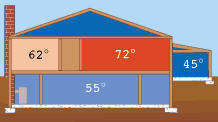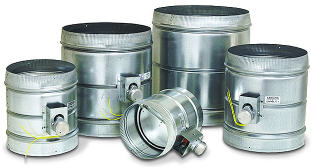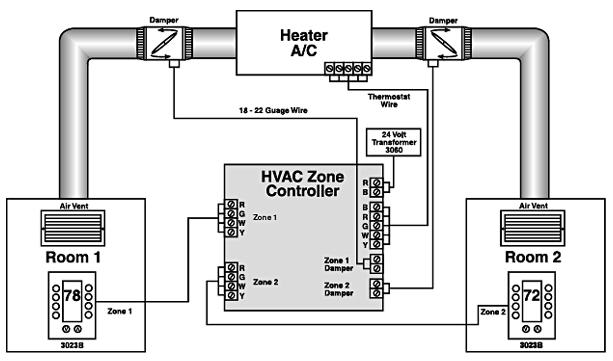Duct Zone Control
 Overview
Overview
The cost of heating (cooling) a home is directly related to the volume of space conditioned and the temperature difference between the inside and outside. Reducing either the volume of space or the temperature difference can dramatically reduce heating (cooling) costs.
The least expensive method is central control of the entire system. A more acceptable method for large houses may be zone control.
Zone control has been a standard feature for residential boiler systems for over 50 years. It has only recently been made economically available for residential forced air systems.
Zone control is not cheap; it is most economical in new construction of large homes with areas that can be easily isolated from the rest of the house.
 Operation
Operation
Zone control can be installed with new equipment in new houses, or retrofit to existing systems. It requires that each zone to be controlled has separate ductwork. It also makes sense that the control space can be physically isolated from the rest of the space. (ie: it makes no sense to shut off the ductwork and yet have open areas to uncontrolled spaces.)
Zone control requires:
- a ducted central heating system
- a duct that can be used to isolate the zone to be controlled
- a separate thermostat for each zone
- a central zone control
- a multi-stage, variable speed furnace works best, but is not required

Economic and Other Considerations
- The cost of each motorized damper is $75 to $150 depending on size
- A central controller is $75 – $200 depending on number of zones and options
- Individual thermostats are $25 – $200 depending on features
- Is zoning for comfort or economic savings? Savings will only result if dramatic temperature reductions (increase for cooling) are consistently performed for long periods of time in controlled zones. Comfort improvement can result with small changes in temperature.
- For very large houses, consider the costs and advantage of multiple furnaces/air conditioners and zoning.
- Consider that spaces with reduced temperatures and air flows can become problem areas for mold and indoor air quality problems related to moisture condensation on cold surfaces and low fresh air volume.
- Several zones on a large single stage furnace can cause short-cycling of the furnace when only one zone may call for a small amount of heat. Multi-stage and multi-speed furnaces work best for zoned systems, but are not required.
More Information
For purchase information on zone controls, visit the www.SmartHome.com web site
Source: Text Bob Fegan 12/2008; Graphics from www.smarthome.com 10/2003; zone graphic from www.slantfin.com 10/2003;
© 2008 Energy Solutions Center400 N. Capitol Street NWWashington, DC 20001 All rights reserved. Legal Contact our webmaster
